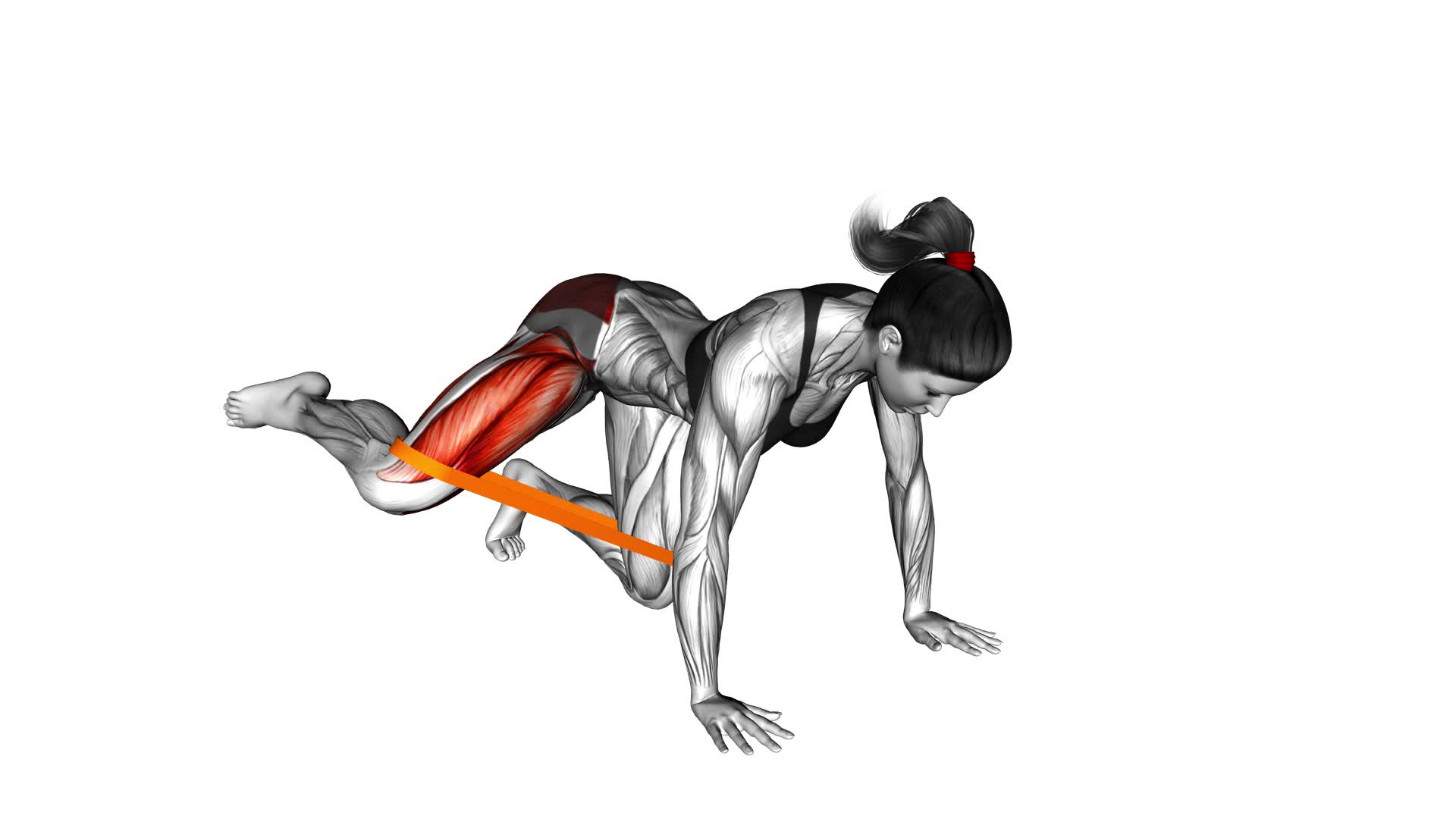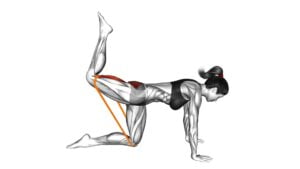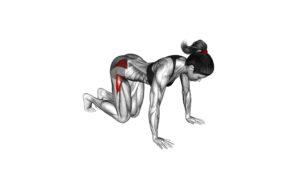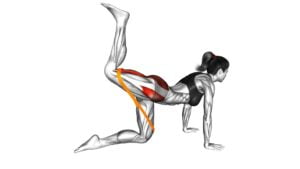Resistance Band Bent Leg Side Kick (kneeling) (female) – Video Exercise Guide & Tips

Are you looking for an effective exercise to tone your legs and strengthen your core? Look no further than the Resistance Band Bent Leg Side Kick.
Watch This Exercise Video
This exercise targets your glutes, hips, and thighs while also engaging your abdominal muscles.
In this video exercise guide, you'll find tips on proper form, choosing the right resistance band, and modifications for all fitness levels.
Get ready to kick your fitness routine up a notch with the Resistance Band Bent Leg Side Kick.
Key Takeaways
- The resistance band bent leg side kick targets the glutes, hips, and thighs while engaging the abdominal muscles.
- Proper form and technique include engaging the core muscles, keeping the back straight and chest lifted, and bending the knees at a 90-degree angle.
- When choosing a resistance band, consider the desired level of challenge and choose a band that aligns with current fitness level and goals.
- Modifications and progressions for the exercise include starting with a lighter resistance band, increasing resistance band tension, adding ankle weights, and performing the exercise on an unstable surface.
Benefits of the Resistance Band Bent Leg Side Kick
You should frequently incorporate Resistance Band Bent Leg Side Kicks into your workout routine because they offer numerous benefits. One of the key benefits is injury prevention. By using resistance bands, you can strengthen the muscles surrounding your hips and knees, which can help prevent common injuries such as strains and sprains. The resistance provided by the bands also helps improve your stability and balance, reducing the risk of falls and other accidents during exercise.
Another advantage of Resistance Band Bent Leg Side Kicks is the activation of multiple muscles. This exercise targets the glutes, hip abductors, and outer thighs, helping to tone and strengthen these areas. Strong glutes and hip abductors are important for overall lower body strength and stability, which can enhance your performance in other exercises and daily activities.
Furthermore, incorporating this exercise into your routine can help improve your overall muscle activation. By using resistance bands, you're adding an extra challenge to the movement, forcing your muscles to work harder. This increased muscle activation can lead to improved muscle strength and definition over time.
Proper Form and Technique for the Exercise
To execute the Resistance Band Bent Leg Side Kick with proper form and technique, continue by maintaining a stable kneeling position and securing the resistance band around your ankles. Here are some key tips to ensure you perform the exercise correctly:
- Engage your core muscles by pulling your belly button towards your spine.
- Keep your back straight and your chest lifted throughout the movement.
- Begin by bending your knees at a 90-degree angle, with your thighs parallel to the ground.
- As you kick your leg out to the side, focus on using the muscles on the outer part of your hip and thigh.
- Control the movement as you bring your leg back to the starting position, maintaining tension on the resistance band.
Proper form and technique are crucial to maximize the benefits of this exercise. By performing the Resistance Band Bent Leg Side Kick correctly, you can improve flexibility in your hips and thighs while targeting the muscles responsible for stabilizing your pelvis and lower body.
For advanced practitioners, there are variations that can be incorporated to increase the challenge, such as using a heavier resistance band or adding ankle weights. Remember to always listen to your body and progress at a pace that feels comfortable for you.
Choosing the Right Resistance Band for Your Fitness Level
When selecting the appropriate resistance band for your fitness level, consider the desired level of challenge and choose a band with the corresponding resistance. There are different types of resistance bands available, each offering different levels of resistance. The three main types are loop bands, tube bands, and therapy bands.
Loop bands are circular bands that can be used for a variety of exercises, such as squats and glute bridges. Tube bands have handles on each end and can be used for exercises like bicep curls and shoulder presses. Therapy bands are flat and can be used for stretching and rehabilitation exercises.
To determine the right resistance level, consider your strength and experience with resistance band exercises. If you're a beginner or have limited strength, start with a lighter resistance band. As you progress and become stronger, gradually increase the resistance. It's important to challenge yourself, but also listen to your body and avoid using a band that's too difficult for you.
Remember to always check the resistance level of the band before purchasing or using it. Resistance levels are usually indicated by color or resistance level (e.g., light, medium, heavy). Choose a band that aligns with your current fitness level and goals. By selecting the right resistance band, you can effectively target and strengthen your muscles during resistance band exercises.
Modifications and Progressions for All Fitness Levels
For modifications and progressions suitable for all fitness levels, consider incorporating variations of the resistance band bent leg side kick (kneeling) exercise. Whether you're a beginner or an advanced fitness enthusiast, these modifications and progressions will help you tailor the exercise to your specific needs and goals.
Here are five options to adapt the resistance band bent leg side kick (kneeling) exercise to your fitness level:
- Start with a lighter resistance band: If you're new to resistance training or have limited strength, begin with a lighter band to ensure proper form and prevent injury.
- Increase resistance band tension: As you become stronger, gradually increase the tension of the resistance band to provide a greater challenge for your muscles.
- Add ankle weights: For an extra challenge, incorporate ankle weights to further engage your leg muscles during the exercise.
- Perform the exercise on an unstable surface: By kneeling on a Bosu ball or balance disc, you'll activate more stabilizer muscles, enhancing your overall strength and balance.
- Combine the exercise with other movements: Integrate the resistance band bent leg side kick (kneeling) exercise into a full-body workout routine to work multiple muscle groups simultaneously.
Common Mistakes to Avoid During the Exercise
When performing the resistance band bent leg side kick exercise, it's important to avoid common mistakes that can hinder your progress.
One common mistake is incorrect posture alignment, which can lead to strain on the lower back and hips.
Another mistake to avoid is a lack of core engagement, as this can decrease the effectiveness of the exercise and increase the risk of injury.
Ensure that you maintain proper posture and engage your core throughout the movement to maximize the benefits of this exercise.
Incorrect Posture Alignment
Maintain proper posture alignment to avoid common mistakes during the Resistance Band Bent Leg Side Kick exercise. Incorrect knee alignment can put unnecessary strain on your joints and increase the risk of injury. Make sure your knee is in line with your ankle and not collapsing inward or outward.
Additionally, lack of hip stability can cause your body to sway and lose balance during the exercise. Engage your core muscles and focus on keeping your hips stable throughout the movement.
Here are five common mistakes to avoid:
- Allowing your knee to collapse inward
- Allowing your knee to collapse outward
- Letting your hips sway from side to side
- Arching your lower back excessively
- Leaning forward or backward instead of maintaining an upright posture
Lack of Core Engagement
To avoid the common mistake of lacking core engagement during the Resistance Band Bent Leg Side Kick exercise, it's important that you focus on activating and strengthening your core muscles throughout the movement.
Core activation is crucial for maintaining stability and control during the exercise. When your core isn't engaged, you may experience difficulty in executing the movement correctly and efficiently. This can lead to muscle imbalances, as other muscles compensate for the lack of core engagement.
To ensure proper core activation, start by bracing your abs and engaging your deep core muscles. Keep your spine neutral and avoid arching your back.
Tips for Incorporating the Resistance Band Bent Leg Side Kick Into Your Workout Routine
To include the Resistance Band Bent Leg Side Kick in your workout routine, start by attaching the resistance band to a stable object. This exercise is a great way to incorporate resistance bands into your routine and add variety to your side kicks.
Here are some tips to help you make the most of this exercise:
- Maintain proper form: Keep your back straight, engage your core, and focus on using your glutes and outer thigh muscles to perform the side kick.
- Control your movements: Slow and controlled movements will help you maximize the benefits of this exercise and reduce the risk of injury.
- Gradually increase resistance: Start with a lighter resistance band and gradually increase the tension as your strength improves. This will challenge your muscles and help you progress over time.
- Combine with other exercises: Incorporate the Resistance Band Bent Leg Side Kick into a full-body workout routine by combining it with other exercises that target different muscle groups.
- Mix up the variations: Experiment with different variations of side kicks, such as straight leg side kicks or diagonal side kicks, to target different areas of your legs and hips.
Frequently Asked Questions
How Many Repetitions of the Resistance Band Bent Leg Side Kick Should I Do in Each Workout?
To determine the number of repetitions for the resistance band bent leg side kick in each workout, consider your fitness level and goals.
Start with 8-12 reps per leg and gradually increase as you get stronger.
Focus on maintaining proper form throughout the exercise, keeping your core engaged and hips stable.
Can I Do the Resistance Band Bent Leg Side Kick Exercise if I Have Knee Pain or Knee Injuries?
If you have knee pain or injuries, it's important to be cautious when doing the resistance band bent leg side kick exercise. Instead, consider alternative knee-friendly exercises to strengthen your lower body.
Focus on exercises that don't put too much stress on your knees, such as bridges, clamshells, or seated leg raises.
It's also crucial to manage knee pain during workouts by using proper form, taking breaks when needed, and listening to your body.
How Long Should I Hold the Kick Position During the Exercise?
During the exercise, it's important to focus on the kick duration and maintaining proper form. To get the most out of the movement, hold the kick position for a few seconds before returning to the starting position.
This will help engage the targeted muscles and improve your balance and stability. Remember to keep your core engaged and your back straight throughout the exercise for optimal results and to avoid any unnecessary strain or injury.
Is It Necessary to Warm up Before Performing the Resistance Band Bent Leg Side Kick?
Before performing the resistance band bent leg side kick, it's highly recommended to warm up your body. Warming up helps increase blood flow to your muscles, improving flexibility and reducing the risk of injury. It prepares your body for the exercise and allows you to perform at your best.
Some benefits of warming up include enhanced performance, increased range of motion, and improved muscle coordination. If you're looking for alternative exercises, you can try standing side kicks or seated side kicks without the resistance band.
Can I Use Ankle Weights in Addition to the Resistance Band for Added Intensity?
Yes, you can use ankle weights in addition to the resistance band for added intensity.
Using ankle weights can provide benefits such as increased resistance and muscle activation during the exercise.
However, it's important to start with lighter weights and gradually increase them to avoid injury.
If you're looking for alternative exercises to further enhance the intensity, you can try incorporating lunges, squats, or leg presses into your workout routine.
Remember to consult a fitness professional for personalized guidance.
Conclusion
Incorporating the resistance band bent leg side kick into your workout routine can provide numerous benefits. This exercise is particularly effective for strengthening your lower body muscles and improving balance. It is important to remember to maintain proper form while performing this exercise. Additionally, choosing the right resistance band for your fitness level is crucial. Many people make common mistakes when performing this exercise, so it is important to be mindful of these and avoid them. Furthermore, it is important to consider modifications or progressions to suit your individual needs. By following these tips, you can effectively utilize the resistance band bent leg side kick to enhance your overall fitness.

Author
Years ago, the spark of my life’s passion ignited in my mind the moment I stepped into the local gym for the first time. The inaugural bead of perspiration, the initial endeavor, the very first surge of endorphins, and a sense of pride that washed over me post-workout marked the beginning of my deep-seated interest in strength sports, fitness, and sports nutrition. This very curiosity blossomed rapidly into a profound fascination, propelling me to earn a Master’s degree in Physical Education from the Academy of Physical Education in Krakow, followed by a Sports Manager diploma from the Jagiellonian University. My journey of growth led me to gain more specialized qualifications, such as being a certified personal trainer with a focus on sports dietetics, a lifeguard, and an instructor for wellness and corrective gymnastics. Theoretical knowledge paired seamlessly with practical experience, reinforcing my belief that the transformation of individuals under my guidance was also a reflection of my personal growth. This belief holds true even today. Each day, I strive to push the boundaries and explore new realms. These realms gently elevate me to greater heights. The unique combination of passion for my field and the continuous quest for growth fuels my drive to break new ground.







